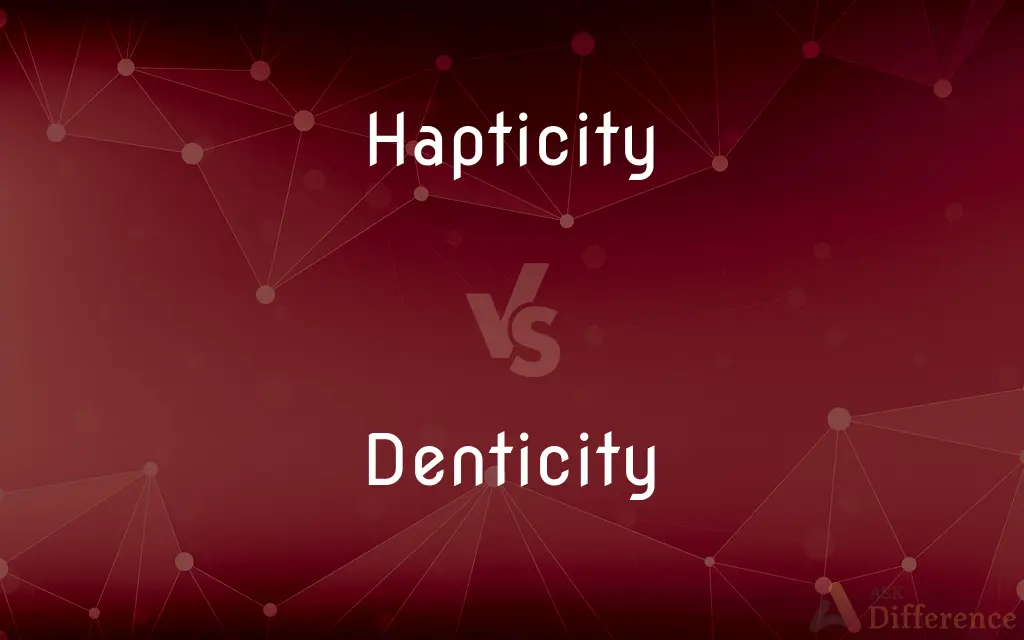Hapticity vs. Denticity — What's the Difference?
By Tayyaba Rehman — Updated on October 26, 2023
Hapticity refers to the number of atom points of attachment on a ligand to a metal. Denticity is the number of donor groups of a ligand bonding to a central metal atom.

Difference Between Hapticity and Denticity
Table of Contents
ADVERTISEMENT
Key Differences
Hapticity and Denticity are terms associated with coordination chemistry, especially when describing ligands and their interaction with central metal atoms. Hapticity refers specifically to the number of contiguous atom points of attachment a ligand might have with a metal in a coordination complex. For example, a ligand might bridge between multiple metal atoms, leading to different hapticities. On the other hand, Denticity involves the number of donor groups in a ligand that can bond to a central metal atom.
Denticity provides a way to classify ligands based on how many places they can attach to a metal through donor atoms. Common terms like bidentate, tridentate, etc., originate from this concept. These terms mean that the ligand can bond at two, three, or more places respectively. Hapticity, meanwhile, emphasizes the continuity or adjacency of attachment points. For ligands with multiple adjacent atoms capable of bonding, the term "hapticity" becomes particularly important.
When discussing the bonding of ligands like cyclopentadienyl anion to metals, Hapticity becomes a significant term. The manner in which these ligands bind can be described in terms of their hapticity. Conversely, Denticity plays a vital role when considering ligands like ethylenediamine. This ligand has two nitrogen atoms, both of which can bond to a metal, making it a bidentate ligand.
In essence, while both Hapticity and Denticity describe the way ligands can bond to metals, they focus on different aspects. Hapticity zeroes in on the contiguous attachment points, and Denticity concerns itself with the number of donor groups a ligand offers for bonding.
Comparison Chart
Definition
Number of contiguous atom points of attachment on a ligand
Number of donor groups of a ligand bonding to a metal atom
ADVERTISEMENT
Usage
Describes continuous attachment points
Classifies ligands by number of bonding sites
Common Ligands
Cyclopentadienyl anion
Ethylenediamine
Relevance
Important for ligands with multiple adjacent bonding atoms
Essential for ligands with multiple donor groups
Descriptor Terms
Refers to the continuity of attachment
Uses terms like bidentate, tridentate, etc.
Compare with Definitions
Hapticity
Measure of the number of atoms of a ligand bound to a metal.
The hapticity of η^5-C5H5 ligand is 5.
Denticity
Classification criterion for ligands based on bonding sites.
A ligand with two bonding sites is termed bidentate due to its denticity.
Hapticity
Representation of contiguous attachment points a ligand offers.
The cyclopentadienyl ligand can have varying hapticity, depending on how it binds to the metal.
Denticity
Indicates the number of atoms on a ligand that can bind simultaneously.
The denticity of EDTA is six, allowing for versatile coordination modes.
Hapticity
Emphasizes the adjacency or continuity of ligand attachment points.
A ligand with a hapticity of three attaches via three adjacent atoms.
Denticity
A descriptor for ligands based on the number of donor atoms.
Ligands with higher denticity often form more stable complexes.
Hapticity
Coordination manner of ligands with multiple contiguous bonding atoms.
The hapticity of a ligand gives insight into its binding manner to the metal.
Denticity
The number of donor groups in a ligand that bond to a metal.
Ethylenediamine has a denticity of two because of its two nitrogen atoms.
Hapticity
A descriptor of the way ligands bind in terms of continuous bonding sites.
Hapticity becomes crucial when discussing ligands that can bridge multiple metal atoms.
Denticity
Represents the multiple points through which a ligand can bond.
Denticity helps predict how ligands will bind to central metal atoms.
Hapticity
(chemistry) A measure of the number of atoms of a ligand that are coordinated to a central atom.
Denticity
Denticity refers to the number of donor groups in a single ligand that bind to a central atom in a coordination complex. In many cases, only one atom in the ligand binds to the metal, so the denticity equals one, and the ligand is said to be monodentate (sometimes called unidentate).
Hapticity
Hapticity is the coordination of a ligand to a metal center via an uninterrupted and contiguous series of atoms. The hapticity of a ligand is described with the Greek letter η ('eta').
Denticity
(chemistry) The number of donor groups from a ligand to the central atom of a coordination compound
Hapticity
The property of being haptic; relation to the sense of touch.
Common Curiosities
Which ligands are typically described using Denticity?
Ethylenediamine is a common ligand described using Denticity.
How is Denticity defined?
Denticity is the number of donor groups in a ligand that bond to a central metal atom.
What's a common ligand discussed in terms of Hapticity?
A common example is the cyclopentadienyl anion.
Can a ligand have both Hapticity and Denticity?
Yes, a ligand can have both, but they describe different bonding aspects.
What does Hapticity refer to?
Hapticity refers to the number of contiguous atom points of attachment a ligand has with a metal.
Why is Hapticity important in coordination chemistry?
It provides insight into the continuous binding manner of ligands to metals.
Can a ligand have a Hapticity of one?
Yes, if it binds through a single contiguous atom.
Can Hapticity change for a ligand?
Yes, depending on how the ligand binds to the metal.
Can a ligand have a Denticity of three?
Yes, it's termed tridentate.
Does Denticity always indicate stronger bonding?
Not necessarily, but ligands with higher denticity often form more stable complexes.
Is Hapticity related to the strength of bonding?
Not directly; it describes how ligands bind, not the bond strength.
Are bidentate and tridentate terms related to Hapticity?
No, they relate to Denticity.
Is Denticity crucial for predicting ligand behavior?
Yes, it helps predict how ligands will bind and the stability of complexes.
How can I determine a ligand's Denticity?
By counting its donor groups that can bond to a metal.
Share Your Discovery

Previous Comparison
Act vs. Deed
Next Comparison
Gas vs. LiquidAuthor Spotlight
Written by
Tayyaba RehmanTayyaba Rehman is a distinguished writer, currently serving as a primary contributor to askdifference.com. As a researcher in semantics and etymology, Tayyaba's passion for the complexity of languages and their distinctions has found a perfect home on the platform. Tayyaba delves into the intricacies of language, distinguishing between commonly confused words and phrases, thereby providing clarity for readers worldwide.
















































